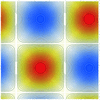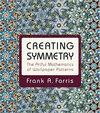issue contents
July 2017 issue

Cover illustration: Tomographic rendering of barium sulfate clusters ingested by a macrophage cell. Multiple projections of the cell were recorded by X-ray holography while sitting in a hydrated environment, and phased by advanced near-field phase-retrieval methods [Krenkel et al. (2017). Acta Cryst. A73, 282-292].
scientific commentaries
Free 

The new holo-TIE approach to cellular imaging described by Krenkel et al. [Acta Cryst. (2017), A73, 282–292] is discussed.
advances
research papers
Open  access
access
 access
accessPhase-contrast X-ray imaging of biological cells in two and three dimensions can be carried out with a low dose, based on free propagation and a setting of optimized wavefronts in cone-beam geometry. In order to reach the required contrast level, images have to be recorded in the holographic regime. The main result of this work is holographic recordings of a quality that is fully amenable to quantitative phase retrieval, beyond previous approximations. Different approaches to sample preparations, data recording and phase retrieval are compared.
Open  access
access
 access
accessA novel, high-resolution X-ray diffraction (XRD) technique that provides completely non-destructive, high-quality XRD analyses of unprepared samples is demonstrated. The method shows great potential in the characterization of cultural heritage artefacts.
short communications
In this study, a first-prototype multi-determinant X-ray constrained wavefunction approach is proposed. The new X-ray constrained wavefunction is written as a linear combination of pre-determined single Slater determinants constructed with extremely localized molecular orbitals. By exploiting experimental structure factors, the novel method enables one to extract resonance structure weights for molecules having a multi-reference character.
foundations
research papers
It is shown how small-angle scattering (SAS) data can be reduced to a set of invariant parameters used to reliably estimate structural moments beyond the radius of gyration, thereby rigorously expanding the actual set of model-free quantities one can extract from experimental SAS data. The pair distance distribution function is also entirely described by this invariant set and the Dmax parameter can be measured.
The forms of the tensors describing thermoelectric transport properties in magnetically ordered crystals are given for the 122 space-time point groups up to second order in an applied magnetic field.
A new crystallographic model is proposed for contraction twinning in magnesium.
Computational mechanics is used to solve the Ising next-nearest-neighbour model in the context of close-packed polytype analysis. The stacking arrangement is seen as an information processing system generating symbols. A general method for solving the stochastic matrix of the random Gibbs field is described and applied. The ∊-machine of the process is built which allows one to describe the system statistically. The occurrence of higher-order polytypes at the borders of the phase diagram is discussed.
book reviews
Free 



 journal menu
journal menu




























